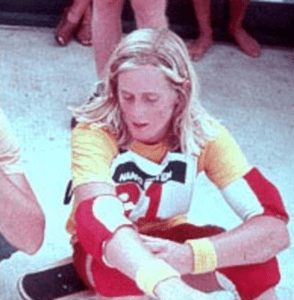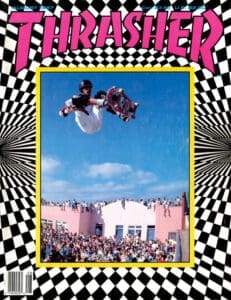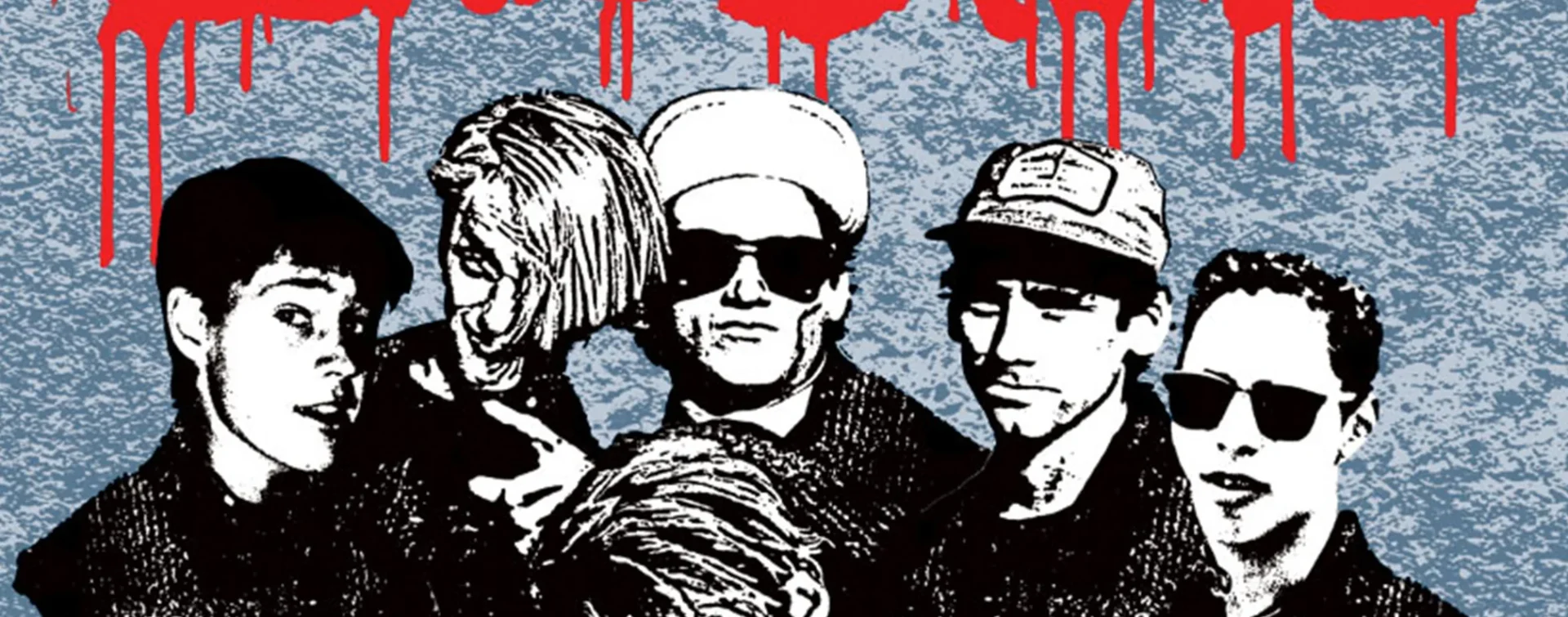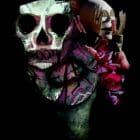Skate or Die: Bones Brigade, The Legends Who Shaped a Generation

Gleaming the Cube (1989) movie poster. Image used under Fair Use. Learn more about the film on IMDb.
Foreword by Executive Creative Director Chris “MUG5” Maguire
Growing up in a small town in Wales, my world was shaped by the neon glow of computer screens, comic book panels, and a mix of inspired guitar riffs, killer beats, and poetic hip-hop lyrics. The 80s pulsed with an energy that traveled far beyond the shores of America, and my friends and I were drawn to it like moths to the streetlight glow. Movies and music gave us glimpses of a world we could only imagine, filling our days with dreams of places we’d never been.
Then one day, as the decade burned into its final years, we walked into a nearby town’s movie theater, sat down, and watched a film that would hit us like a bolt of lightning: Gleaming the Cube. There, in the dim theater, we found ourselves transported to California’s sun-drenched streets, where skateboards sliced through the air. Here was skateboarding—something wild and visceral, a rush we didn’t even know we’d been waiting for. As the credits rolled, I felt something shift deep inside. I didn’t know it then, but this movie had pulled back the curtain on a legendary skate crew: the Bones Brigade.
After Gleaming the Cube, my friends and I were possessed. We built DIY ramps from scrap wood and bricks, scrounged up skate magazines, and absorbed everything we could about tricks and techniques. We crashed and scraped our way through it, fueled by a culture of rebellion that called to us. Without realizing it, we had joined a movement that would stick with us forever. To this day, skateboards and the culture surrounding them remain woven into my life.
Now, I’m here to share stories of the Bones Brigade that I’ve learned over time—from them being the first crew to carve out a place for skateboarding on the world stage, to a crew who broke bones and barriers, and that became a defining force in skateboarding and beyond. From the cracked streets of California to the dusty movie theater in my Welsh hometown, the Bones Brigade’s impact stretched across continents, reaching kids like me who lived thousands of miles away. This is their story, and it’s one that echoes, even now.
MAIN IMAGE: Bones Brigade: An Autobiography movie poster featuring iconic members. Image used under Fair Use. Original release announcement on the Powell-Peralta blog.
A Culture in Motion: The Birth of Bones Brigade

Photo of Stacy Peralta from Wikimedia Commons, used under CC BY-SA 4.0 license. Image by Mike Baird. Stacy Peralta helped shape skateboarding culture as a co-founder of the Bones Brigade. Original image on Wikimedia Commons.
Skateboarding in the late 70s was a renegade’s art, twisting between the concrete ruins and empty pools of California’s urban sprawl. It was an underground symphony of scraped knees, scarred elbows, and decks slapped against sun-baked asphalt. Back then, skating wasn’t a sport, not in the way the mainstream saw it. It was rebellion—a movement for the kids who didn’t fit neatly into the rows of Little League or the Friday night football lights. Skate culture thrived in the cracks, in the forgotten places. But the tides were shifting, and this once-hidden world was on the edge of an explosion.
Enter Powell-Peralta—a duo that would rewrite the rules. Stacy Peralta, a skater with the mind of a filmmaker, saw potential where others saw punks. Partnering with George Powell, who had an almost alchemical touch when it came to board-making, the two had a vision that would turn the sport on its head. Powell-Peralta didn’t just want a team; they wanted a revolution, a crew that would embody the raw spirit of skateboarding, pushing the limits in ways no one else dared to.
Stacy Peralta had an eye for talent and knew the skate scene better than anyone. He handpicked a crew of young skaters, each one bringing a unique fire to the pavement. This wasn’t just a group of kids with boards; this was the Bones Brigade. Tony Hawk, Rodney Mullen, Steve Caballero, Mike McGill, Lance Mountain, Alan Gelfand and Tommy Guerrero. The Brigade was a band of poets in motion, each with a style so distinct it couldn’t be replicated—Peralta’s brigade personified the art of rebellion.
In 1982, The Bones Brigade Video Show dropped, a gritty, grainy love letter to skateboarding that would kick-start a phenomenon. Directed by Peralta himself, this was more than a skate film; it was a manifesto, an invitation to kids who were hungry for something real. It captured the raw energy of the streets and gave skateboarding a new language. Bones Brigade pushed boundaries and tore down walls, showing the world what could happen when you dared to dream with wheels underfoot.
“The energy and rawness of those early skate videos shaped how I approach filmmaking. It showed me that it’s all about staying true to the moment.” – Spike Jonze, filmmaker and former skate videographer
The film was a glimpse into a world where gravity was a suggestion, where every push and slide had a heartbeat of its own. Through Peralta’s lens, the Bones Brigade became something mythic, drawing kids in from the sidewalks of California to the rain-soaked streets of Wales. The Brigade was a crew of heroes, legends whose names echoed on cracked pavements around the world. They inspired kids to pick up a board, to fall, to get back up, and to find the edge of what was possible. In those early days, the Bones Brigade skated not for fame, but for the thrill, for the way it made them feel free. They didn’t need fame or the spotlight because they were the light, illuminating the path for generations to follow. And as the years went on, with every video they released, they left an imprint on skateboarding and culture itself. The Bones Brigade embodied freedom and rebellion, carving their names into the history of a sport that was as much about the heart as it was about the board.
This is the beginning of their story, one that would go on to inspire countless others, myself included, to pick up a board, roll down an empty street, and let the world fall away.
Pioneers of the Pavement: The Bones Brigade Members
Each member of the Bones Brigade brought something revolutionary to skateboarding. They were pioneers, innovators, and cultural icons whose influence extended beyond the ramps and into the heart of skateboard culture. Here’s a brief glimpse into each member’s journey, both within the Brigade and in their individual lives, showcasing how they forever changed skateboarding and culture.
Alan Gelfand – The Original Ollie
Alan “Ollie” Gelfand was a key figure in skateboarding history, known for inventing the trick that would revolutionize the sport: the ollie. This simple yet groundbreaking move allowed skaters to jump with their boards, making it possible to clear obstacles and perform tricks previously thought impossible. Gelfand’s invention didn’t just change vert skating—it laid the foundation for modern street skating, a style Rodney Mullen would later adapt and popularize.
After his days as a skater, Gelfand found success in auto racing, competing in endurance events and eventually opening the German Car Depot, an automotive repair shop specializing in German cars. His legacy within skateboarding endures, with the ollie forever immortalized in the Oxford English Dictionary, a tribute to his impact on the sport.
“The ollie is more than a trick. It’s the gateway to everything else in skateboarding. Without Alan Gelfand’s invention, skateboarding wouldn’t be what it is today.” – Tony Hawk
Tony Hawk – The Birdman of the Vert
Young, lanky, and endlessly determined, Tony Hawk joined the Bones Brigade as a teenager with a seemingly impossible dream: to dominate the vertical ramp. Known as “The Birdman,” Hawk redefined vert skating, inventing moves like the stalefish, Madonna, and eventually the legendary 900. His style was fearless, setting a new standard for what could be done on a skateboard.
After his time with Bones Brigade, Tony Hawk became a household name, turning skateboarding into a mainstream phenomenon. Through the Tony Hawk’s Pro Skater video game series, he brought skate culture into millions of homes, inspiring new generations of skaters. Today, Tony Hawk is celebrated as a global ambassador for the sport, with a foundation that builds skateparks in underserved communities.
“Tony Hawk made us believe that flying was possible. He didn’t just push the boundaries; he erased them.” – Rodney Mullen
Rodney Mullen – The Freestyle Wizard
While Tony Hawk ruled the ramps, Rodney Mullen was creating the foundation of modern street skating. Known for his quiet intensity and almost scientific approach, Mullen invented tricks like the kickflip, heelflip, and of course, adapted Gelfand’s ollie for flatground, which made street skating a possibility. His style blended technical precision with a raw, poetic edge that set him apart.
In the years since the Bones Brigade, Mullen has continued to innovate and inspire. His thoughts on creativity and resilience have made him a sought-after speaker, and he’s become a symbol of reinvention in skateboarding and beyond.
“Rodney doesn’t just do tricks. He creates new possibilities. He’s the reason we have a language for skateboarding today.” – Tony Hawk
Steve Caballero – The Cab and Beyond
Steve Caballero was the powerhouse of Bones Brigade, known for his fearless approach and relentless energy. Caballero brought an infectious spirit to the team, constantly pushing his own limits. His signature trick, the Caballerial, remains a rite of passage for skaters worldwide.
Beyond skateboarding, Caballero has pursued a successful career in music and art. He continues to compete in skateboarding events and inspire younger skaters with his passion and dedication to the sport.
“Cab embodies the soul of skateboarding. He’s been there, done it all, and he’s still out there pushing the limits. That’s true dedication.” – Lance Mountain
Mike McGill – Innovator of the McTwist
For Mike McGill, skating was about pushing the envelope and making the impossible a reality. His invention of the McTwist—a 540-degree aerial spin—opened up new possibilities for vert skaters everywhere. McGill’s gritty style and fearless attitude perfectly embodied the Bones Brigade’s rebellious spirit.
Today, McGill runs his own skate shop and remains an influential figure in the skateboarding community. His dedication to the sport and his impact on its evolution have secured his status as a skateboarding legend.
“McGill’s McTwist was a turning point. He showed us that there were no limits to what we could do.” – Steve Caballero
Lance Mountain – The People’s Skater
Lance Mountain was the everyman of the Brigade, a skater who made it all seem possible. Known for his inventive style and humor, Lance Mountain became a fan favorite. He could skate any terrain, making him one of the most versatile members of Bones Brigade.
Lance Mountain has since become an artist, continuing to influence young skaters by showing that skateboarding is about expression as much as skill. His authentic approach has made him a beloved figure in skate culture. Mountain is celebrated for his artistic and design work within the skateboarding community, such as his collaboration on skate graphics and his contributions to skate deck designs. He has also been involved in curating art exhibitions and remains highly active as an artist.
“Lance brought personality to skateboarding. He reminded us that it’s about having fun, about expression, about being yourself.” – Tommy Guerrero
Tommy Guerrero – The Soul of the Streets
Tommy Guerrero brought a soulful, streetwise vibe to the Bones Brigade. His smooth, flowing style helped popularize street skating, showing that skateboarding wasn’t limited to ramps or parks—it was a way of life.
After his skateboarding career, Guerrero became a respected musician, crafting music that reflects his skating roots. His ability to fuse skate culture and music has made him an icon in both worlds, inspiring skaters and musicians alike.
“Tommy’s skating was like jazz. It had a flow, a rhythm, a style that was all his own. He turned the streets into his canvas.” – Stacy Peralta
Together, these pioneers formed a team unlike any other. They pushed and inspired each other, carving out a legacy that resonates to this day. The Bones Brigade was a movement, a revolution, a reminder that skateboarding is about freedom, creativity, and the courage to chase dreams. Each of these legends paved the way for generations of skaters, forever changing the way we see the world on four wheels.
The Bones Brigade Phenomenon: Skate Culture’s Greatest Legacy
The Bones Brigade ignited a movement, transforming skateboarding from a scrappy subculture into a worldwide phenomenon. This legendary skate crew defined what skate culture could be. In the 80s, with raw, DIY skate videos and appearances in the media, Bones Brigade became symbols of freedom, creativity, and rebellion. Through films that captured the heart of skateboarding, they inspired a generation to see skateboarding as more than a sport—it was a way of life, a culture, a revolution.
“Seeing the Bones Brigade in action made me realize that skateboarding wasn’t just American—it belonged to all of us around the world.” – Mark Gonzales, pro skater and artist
The Power of DIY Skate Videos
Back in the early 80s, skateboarding videos weren’t part of the culture—until The Bones Brigade Video Show hit the scene. Directed by Stacy Peralta, it was an invitation, an anthem for skaters who were hungry for something real. The Bones Brigade DIY skate videos showed the world that skateboarding was about pushing boundaries, breaking rules, and creating art on four wheels. Peralta captured every crash, every grind, every moment of victory, showing kids everywhere that skateboarding could be a way of life.
The Bones Brigade followed up with videos like Future Primitive and The Search for Animal Chin, each film pushing the culture even further. These gritty, grainy tapes spread like wildfire. In basements, garages, and skate parks, kids would crowd around to watch their heroes. Each new video was a revelation, inspiring skaters to make their own tapes, launching a DIY movement that’s still alive today. Now, with skateboarding videos everywhere—from YouTube to TikTok—the spirit of the Bones Brigade lives on, inspiring every skater who picks up a camera and hits record.
Peralta’s approach to filming was unconventional, a guerrilla-style cinematography that used handheld shots, low angles, and rapid cuts to create an immersive experience. He and his small crew shot from the back of a truck, from the ground, and from rooftops, all in the quest to capture the raw energy of skateboarding. With no budget for high-end equipment, they made do with what they had, turning limitations into strengths. The result was a style that felt authentic, bringing the viewer right into the action.
“We didn’t have a big budget or a studio. What we had was passion, grit, and a bunch of skaters who wanted to show the world what they could do.” – Stacy Peralta
These Bones Brigade films became the visual language of skate culture. From the gritty streets of California to makeshift ramps around the world, the Brigade’s DIY spirit fueled a movement that continues to inspire skaters and creators everywhere. In every YouTube skate video, every Instagram clip, you can feel the pulse of the Bones Brigade, a testament to their lasting influence on skateboarding and DIY media. They showed that creativity isn’t about having the right tools; it’s about passion, vision, and a relentless drive to capture the art of motion.
Thrasher Magazine & The Rise of Skate Media

Cover of Thrasher magazine, August 1987. Image used under Fair Use.
Alongside their raw videos, Bones Brigade’s exploits reached a global audience through skate magazines like Thrasher which was the pulse of skate culture. Its pages were gritty, unapologetic, and filled with the raw energy that skateboarding brought to the streets. Thrasher became the gospel, the unfiltered truth of what it meant to be a skater. Through iconic covers, interviews, and photos, the Brigade’s fearless tricks and bold style were broadcast to fans across the world.
Like me, for kids in small towns and big cities alike, Thrasher was a lifeline, a window into a world where skateboarding meant freedom. The Bones Brigade shaped skate culture and became its icons, plastered on bedroom walls and school notebooks. They weren’t just featured in the magazine; they were the magazine, defining the spirit of skateboarding in the 80s and beyond. Every issue reminded fans that skateboarding was a lifestyle, a community, and a rebellion worth fighting for.
Fashion & Language: Defining a Generation
The Brigade’s iconic look—baggy jeans, Vans sneakers, oversized tees, and flat-brim caps—quickly became the uniform of a generation. Their style reshaped streetwear and seeped into the mainstream. Major brands took note, and soon skate-inspired clothing became a staple of 90s fashion, bridging the gap between streetwear and high fashion.
“Skateboarding wasn’t just a sport to them. It was an art form. It was their voice, and magazines like Thrasher helped amplify it.” – George Powell
Beyond their look, the Bones Brigade helped popularize skate slang, with words like “stoked,” “gnarly,” and “shredding” entering everyday language. These phrases went on to become part of the cultural vernacular, immortalizing the free-spirited, rebellious energy of the skate scene. Today, brands like Supreme, Thrasher, and even high-end fashion houses reflect this legacy, drawing on skateboarding’s mix of DIY ethos and countercultural attitude.
Music Integration: The Punk & Hip-Hop Soundtrack
Skateboarding and music have always been inseparable, and the Bones Brigade videos were no exception. Their films pulsed with punk rock and hip-hop tracks that added a gritty soundtrack to the flips and grinds. Bands like Black Flag and the Dead Kennedys became the pulse of skate sessions, fueling the sense of rebellion and raw energy that defined the culture.
Later, when Tony Hawk’s Pro Skater video game hit shelves in the late 90s, it cemented this connection. With a soundtrack featuring bands like Goldfinger and Rage Against the Machine, the game brought skate culture into millions of homes. Players weren’t just landing tricks—they were immersed in the sounds of skate culture, which helped fuel the rise of punk and hip-hop as the defining soundtracks of a generation.
“Punk and skateboarding were more than just scenes—they were about showing up, making your own rules, and leaving a mark. The Bones Brigade did for skateboarding what we tried to do for music: make it something that means something.”
The Influence on Pop Culture: Movies, TV, and Video Games
Beyond the pages of magazines and the frames of skate videos, the Bones Brigade stepped into pop culture. Their influence spread through iconic skate movies like Gleaming the Cube, a film that didn’t just tell a story about skating—it showed the world the raw, thrilling reality of skate culture. Tony Hawk and Rodney Mullen doubled for Christian Slater, performing tricks that captured the imagination of audiences everywhere. These appearances introduced skateboarding to a new audience, turning Bones Brigade into household names.
As skate culture continued to grow, the Brigade’s influence expanded into TV shows, video games, and even fashion. Bones Brigade became cultural icons, shaping an entire generation’s view of what it meant to be fearless, creative, and free.
Must-Watch Media for Skate Culture Fans
Gleaming the Cube (1989) – Starring Christian Slater, with stunts by Tony Hawk and Rodney Mullen.
The Search for Animal Chin (1987) – A Bones Brigade classic, directed by Stacy Peralta.
Bones Brigade: An Autobiography (2012) – A documentary featuring interviews with the original crew.
Thrashin’ (1986) – A cult classic with appearances from Tony Hawk and other skaters.
Lords of Dogtown (2005) – Chronicles the rise of skateboarding through the Z-Boys, who inspired the Bones Brigade.
Voices of Influence: Modern Reflections on Bones Brigade
The Bones Brigade’s influence can still be seen through the eyes of modern skaters, artists, and musicians who grew up watching their videos and absorbing their rebellious ethos. From pro skaters like Nyjah Huston to street artists like Shepard Fairey, Bone Brigade’s legacy continues to shape creative minds across the globe.
“The Bones Brigade made us believe that we could do it ourselves. Watching them as a kid showed me that skating is about the freedom to create something new every time you step on a board.” – Nyjah Huston
Artists, musicians, and skaters continue to draw from the DIY spirit the Bones Brigade embodied. Their films were visual manifestos that showed what could be done with passion, a camera, and a creative vision. Skaters like Lizzie Armanto have mentioned how watching Bones Brigade helped them see skateboarding as an art form and a means of self-expression.
“I always admired how the Brigade stuck to their guns. They weren’t trying to be mainstream—they made the mainstream come to them. That’s something I think about with my art and my business.” – Lizzie Armanto
The DIY Spirit in Art & Business
Beyond skating, Bones Brigade’s influence can be seen in the entrepreneurial spirit of today’s creatives. Skateboarders, artists, and brand founders have embraced Bones Brigade’s DIY approach, building careers that stay true to their roots. This ethos has inspired not just tricks but entire businesses, with brands like Supreme and independent skate shops carrying forward the spirit of independence that Bones Brigade popularized.
“Bone Brigade’s style was raw and real, and that’s what I try to bring into my art. Their influence goes beyond skating—it’s about pushing boundaries in everything you do.” – Shepard Fairey
The Legacy of Bones Brigade
Through the years, the Bones Brigade has continued to influence art, fashion, and even music. Tommy Guerrero’s transition from skater to musician embodies the spirit of skate culture’s blend with creative expression. Each member of the Bones Brigade brought a piece of skate culture into the mainstream, infusing it with an energy that remains as powerful now as it was back then. The Bones Brigade were architects of a movement, paving the way for skateboarding’s place in pop culture. As icons of 80s skateboarding, Bones Brigade left a mark that no one can erase.
Skate culture has evolved over the decades, but the heart and soul of it remain the same. The Bones Brigade were pioneers, and their spirit still pulses through skate parks and streets around the world. Today, skateboarding is a global sport, but the DIY ethos that Bones Brigade championed still drives skaters, artists, and creators everywhere to push boundaries and defy convention. The Bones Brigade transformed skateboarding into a global movement. Even as the sport grows more popular, the essence of skate culture—freedom, rebellion, and creativity—continues to inspire new generations. Skaters today, from pro athletes to weekend warriors, carry forward Bones Brigade’s legacy each time they pick up a board and hit the pavement.
“They are the most important skate team in the history of skateboarding. They were the Beatles, and every other skate team since has been just another band.” – Jeff Grosso, skateboarding legend and historian
The Bones Brigade’s influence reaches beyond skateboarding, embodying the very spirit of creative rebellion. At RIOT, we celebrate this ethos in everything we do, from pushing the limits of filmmaking and design to embracing bold, uncompromising visions. Bones Brigade showed us that the best way to create is to be true to yourself, a message that resonates deeply with us.
The Bones Brigade legacy lives on through every skater who grinds a rail, every artist who picks up a paintbrush, and every musician who shouts against the mainstream. As we celebrate their impact, we invite you to embrace that same spirit—whether through skateboarding, art, music, or any creative pursuit that speaks to you. Keep the legacy of the Bones Brigade alive, and remember that creativity, at its best, is about breaking the rules and forging your own path.




